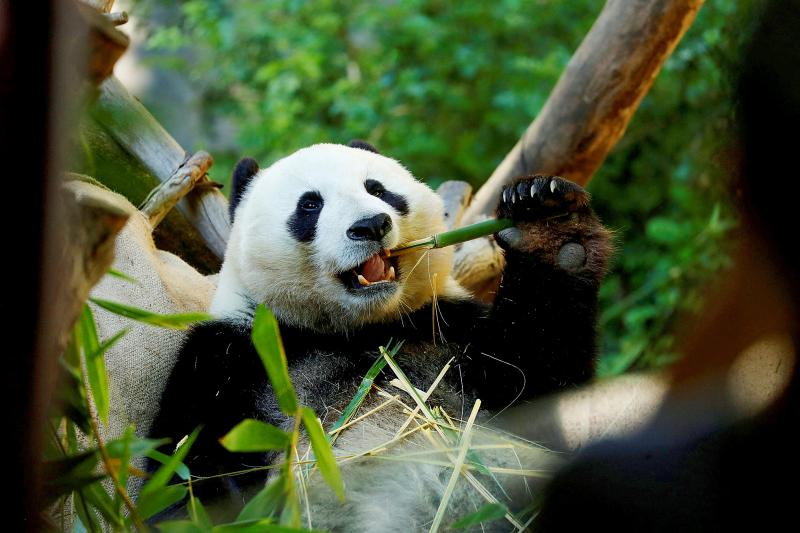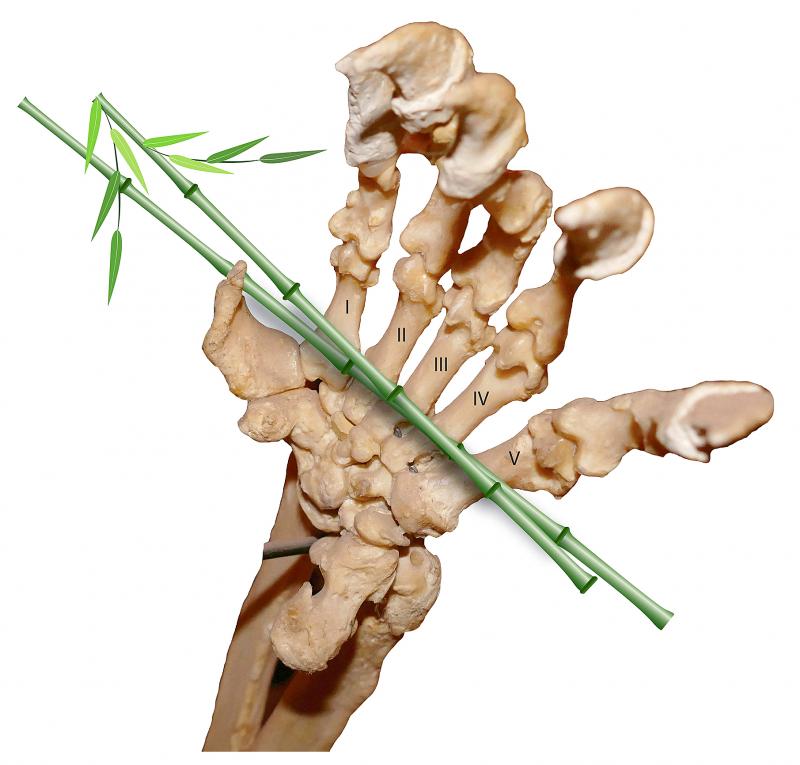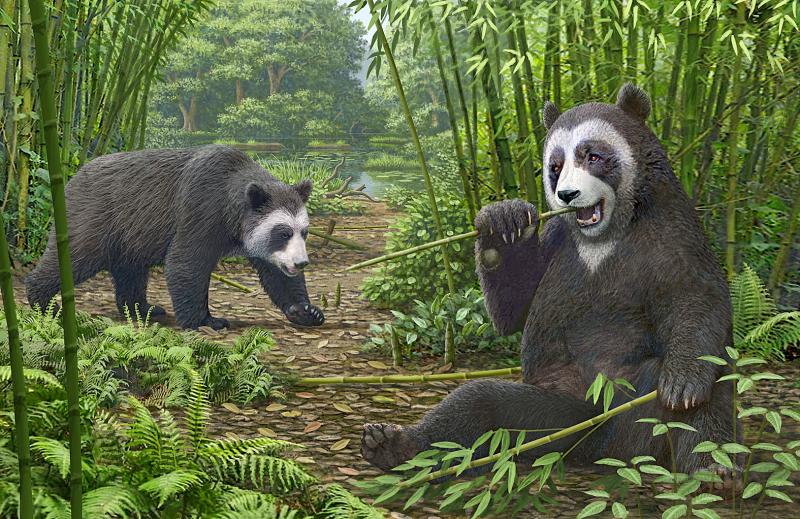Fossils unearthed in China are helping scientists get a better grasp on one of the marvels of evolution: the giant panda’s false thumb, which helps this veggie-loving bear munch the bamboo that makes up most of its diet.
Researchers said on Thursday they discovered near the city of Zhaotong in northern Yunnan Province fossils about 6 million years old of an extinct panda called Ailurarctos that bore the oldest-known evidence of this improvised extra digit — actually a greatly enlarged wrist bone called the radial sesamoid.
It closely resembled the false thumb of modern pandas, but is a bit longer and lacks the inward hook present on the end in the extant species that provides even greater ability to manipulate bamboo stalks, shoots and roots while eating.

Photo: Reuters
The false thumb is an evolutionary adaptation to augment the existing five actual digits of the panda’s hand. A bear’s hand lacks the opposable thumb possessed by humans and various primates that enables the grasping and handling of objects using the fingers. The false thumb serves a similar function.
“It uses the false thumb as a very crude opposable thumb to grasp bamboos, sort of like our own thumbs except it is located at the wrist and is much shorter than human thumbs,” said Natural History Museum of Los Angeles County paleontologist Xiaoming Wang, lead author of the research published in the journal Scientific Reports.
Ailurarctos was an evolutionary forerunner of the modern panda, smaller but with anatomical traits signaling a similar lifestyle including a bamboo diet. The modern panda’s false thumb has some advantages over the earlier version.

Photo: Reuters
“The hooked false thumb offers a tighter grasp of the bamboo and, at the same time, its less-protruded tip — because of the bended hook — makes it easier for the panda to walk. Think of the false thumb as being stepped on every time the panda walks. And therefore, we think that is the reason that the false thumb in modern pandas has become shorter, not longer,” Wang said.
The panda’s tight grip on bamboo acts against the jerking action of the mouth in order to quickly break food into bite-size chunks, Wang added.
The researchers initially found an Ailurarctos arm bone in 2010, then discovered teeth and the false thumb in 2015, giving them a much better understanding of the animal. Until now, the oldest-known evidence of this thumb-like structure dated to fossils from about 102,000-49,000 years ago in the same panda species alive today.

Photo: Reuters
The false thumb lets pandas hold bamboo to eat but not rotate the food as a true thumb would allow.
“One of the most important features of human beings and their primate relatives is the evolution of a thumb that can be held against other fingers for precise grasping. The panda’s false thumb is far less effective than the human thumb, but it is enough to provide the giant panda with the grasping ability to eat bamboo,” said paleontologist and study co-author Tao Deng of the Chinese Academy of Sciences in Beijing.
Pandas, one of the world’s eight bear species, once inhabited large swathes of Asia. They now live primarily in temperate forests in the mountains of southwestern China, with a wild population estimated under 2,000.
A panda’s diet is 99 percent vegetarian, though they do sometimes eat small animals and carrion. Because of their inefficient digestive system, pandas consume large amounts to meet their nutritional needs — 12-38kg of bamboo while eating up to 14 hours a day.
The false thumb was not present in another closely related bear that lived about 9 million years ago, the researchers said.
“This is a great innovation — transformation of a minor bone into an element that is useful for a particular purpose,” said Harvard University paleobiologist and study co-author Lawrence Flynn.

Last week Joseph Nye, the well-known China scholar, wrote on the Australian Strategic Policy Institute’s website about how war over Taiwan might be averted. He noted that years ago he was on a team that met with then-president Chen Shui-bian (陳水扁), “whose previous ‘unofficial’ visit to the US had caused a crisis in which China fired missiles into the sea and the US deployed carriers off the coast of Taiwan.” Yes, that’s right, mighty Chen caused that crisis all by himself. Neither the US nor the People’s Republic of China (PRC) exercised any agency. Nye then nostalgically invoked the comical specter

Relations between Taiwan and the Czech Republic have flourished in recent years. However, not everyone is pleased about the growing friendship between the two countries. Last month, an incident involving a Chinese diplomat tailing the car of vice president-elect Hsiao Bi-khim (蕭美琴) in Prague, drew public attention to the People’s Republic of China’s (PRC) operations to undermine Taiwan overseas. The trip was not Hsiao’s first visit to the Central European country. It was meant to be low-key, a chance to meet with local academics and politicians, until her police escort noticed a car was tailing her through the Czech capital. The

April 15 to April 21 Yang Kui (楊逵) was horrified as he drove past trucks, oxcarts and trolleys loaded with coffins on his way to Tuntzechiao (屯子腳), which he heard had been completely destroyed. The friend he came to check on was safe, but most residents were suffering in the town hit the hardest by the 7.1-magnitude Hsinchu-Taichung Earthquake on April 21, 1935. It remains the deadliest in Taiwan’s recorded history, claiming around 3,300 lives and injuring nearly 12,000. The disaster completely flattened roughly 18,000 houses and damaged countless more. The social activist and

Over the course of former President Ma Ying-jeou’s (馬英九) 11-day trip to China that included a meeting with Chinese Communist Party (CCP) leader Xi Jinping (習近平) a surprising number of people commented that the former president was now “irrelevant.” Upon reflection, it became apparent that these comments were coming from pro-Taiwan, pan-green supporters and they were expressing what they hoped was the case, rather than the reality. Ma’s ideology is so pro-China (read: deep blue) and controversial that many in his own Chinese Nationalist Party (KMT) hope he retires quickly, or at least refrains from speaking on some subjects. Regardless